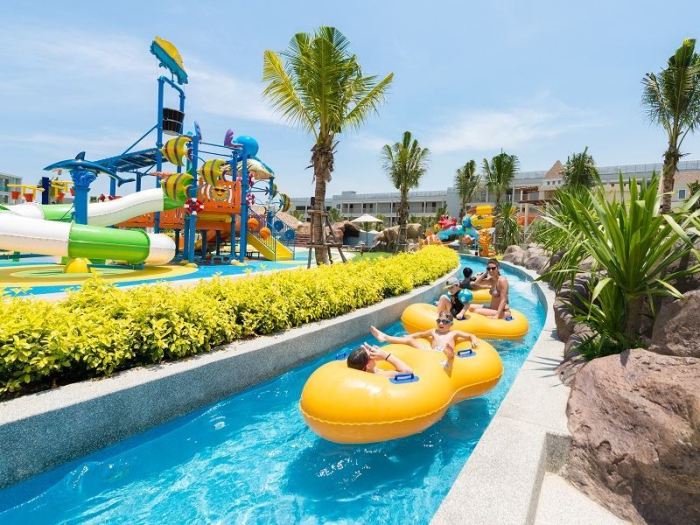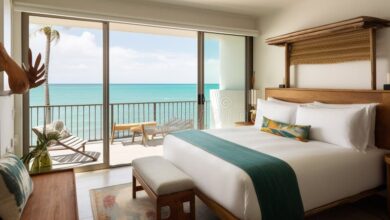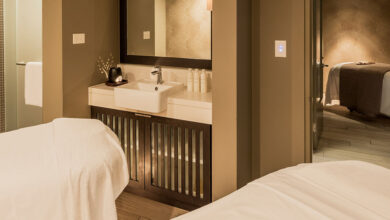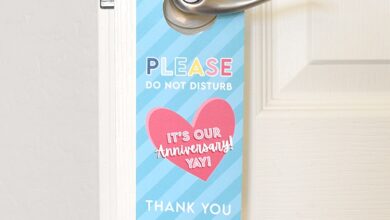Family-Friendly Hotels A Comprehensive Guide
Family-Friendly Hotels are more than just a place to lay your head; they’re destinations designed for creating lasting memories. This guide delves into what makes a hotel truly family-friendly, exploring everything from essential amenities and ideal locations to smart pricing strategies and exceptional guest experiences. We’ll uncover the key factors that families consider when choosing a hotel, highlighting the differences in needs between families with infants, toddlers, and teenagers, and how hotels cater to these diverse needs.
From budget-friendly options to luxurious resorts, we’ll cover the spectrum of family-focused accommodations.
We’ll examine the importance of safety features, childproofing, and accessible design, ensuring that all families, regardless of their individual needs, can enjoy a comfortable and worry-free stay. Furthermore, we’ll discuss effective marketing techniques for attracting families, including the role of online reviews and social media engagement. Ultimately, our aim is to provide a holistic understanding of what constitutes a truly exceptional family-friendly hotel experience.
Defining “Family-Friendly”: Family-Friendly Hotels
The term “family-friendly” when applied to hotels encompasses much more than just allowing children. It signifies a commitment to providing a welcoming and enjoyable experience for families of all sizes and with children of varying ages. A truly family-friendly hotel anticipates and caters to the specific needs and preferences of families, creating a positive and stress-free vacation experience for everyone.Family-friendliness is a multifaceted concept, built upon several key factors.
These factors contribute to a positive experience for families and differentiate a family-friendly hotel from a standard one. The presence of certain amenities, the overall atmosphere, and the responsiveness of the staff all play crucial roles in determining whether a hotel is truly family-oriented.
Amenities and Services Appealing to Families with Young Children
Many amenities and services directly cater to the needs of families with young children. These features can significantly enhance the family vacation experience, reducing stress and allowing parents to relax and enjoy their time away.
- Kid-Friendly Pools: Hotels often feature separate children’s pools with shallow ends and water features designed for younger children, providing a safe and fun environment for swimming and splashing. These might include water slides specifically designed for smaller children, ensuring both safety and entertainment.
- Kids’ Clubs: Many hotels provide supervised childcare programs, offering a variety of activities and entertainment for children of different age groups. This gives parents valuable time for themselves while ensuring their children are well-cared for and engaged in age-appropriate activities. Some clubs offer themed days, arts and crafts, and games.
- High Chairs and Cribs: The availability of high chairs in restaurants and cribs in rooms is essential for families with infants and toddlers. This demonstrates a commitment to accommodating the practical needs of families with young children, ensuring their comfort and convenience.
- Family Suites: Larger suites or connecting rooms provide families with ample space, offering separate sleeping areas for parents and children. This improves privacy and comfort, particularly beneficial for families with multiple children.
- On-site Restaurants with Kid-Friendly Menus: Restaurants offering kid-friendly options and a relaxed atmosphere can make dining out with children significantly easier and more enjoyable. These menus often feature familiar and appealing choices for children.
Differences in Needs and Preferences Across Age Groups
The needs and preferences of families vary significantly depending on the age of their children. Catering to these differences is essential for a truly family-friendly establishment.Families with infants require different amenities than families with teenagers. For example, families with infants prioritize cribs, high chairs, and possibly even a kitchenette or access to a refrigerator for storing baby food.
Families with toddlers may focus on safety features, play areas, and kid-friendly meals. Teenagers, on the other hand, might appreciate access to Wi-Fi, gaming areas, or organized activities that cater to their interests.
Family-Friendly Offerings: Budget Hotels vs. Luxury Resorts
While both budget hotels and luxury resorts can offer family-friendly amenities, the scope and quality differ significantly.Budget hotels typically provide basic amenities such as cribs and high chairs upon request. They might offer a small play area or a designated children’s section in the pool. However, elaborate kids’ clubs or extensive family suites are less common. In contrast, luxury resorts often boast extensive family-friendly facilities, including multiple pools, lavish kids’ clubs with extensive programs, spacious family suites with dedicated kids’ areas, and specialized childcare services.
The difference lies not just in the availability of amenities but also in the quality and range of services provided. For instance, a luxury resort might offer babysitting services, while a budget hotel may only offer limited childcare options.
Amenities and Services
Family-friendly hotels go beyond just offering a place to sleep; they provide a comprehensive experience designed to cater to the needs of families traveling together. This involves a thoughtful selection of amenities and services that enhance comfort, convenience, and create lasting memories. The right mix can significantly impact a family’s overall satisfaction and encourage repeat visits.
A key aspect of creating a truly family-friendly environment lies in providing amenities that cater to the diverse needs of all family members, from toddlers to teenagers and parents. This includes practical conveniences as well as fun and engaging activities. Hotels that excel in this area understand the importance of anticipating and addressing the unique challenges of family travel.
Essential Amenities for Family-Friendly Hotels
The following table Artikels essential amenities, categorized by type, description, and importance rating. This helps hotels prioritize their offerings and ensure they meet the expectations of their target audience.
| Amenity Type | Description | Importance Rating |
|---|---|---|
| Kid-Friendly Rooms | Rooms equipped with cribs, extra beds, child-proof outlets, and possibly family-sized bathrooms. | High |
| On-site Dining | Restaurants offering kid-friendly menus, high chairs, and family-style seating options. | High |
| Swimming Pool | A clean and well-maintained pool, possibly with a separate shallow area for toddlers. | High |
| Play Area/Games Room | An indoor or outdoor space dedicated to children’s play, with age-appropriate equipment. | Medium |
| Laundry Facilities | Convenient in-room laundry or access to a shared laundry room. | Medium |
| High-Speed Internet | Reliable Wi-Fi access throughout the hotel. | Medium |
| Babysitting Services | Pre-arranged babysitting services with vetted and qualified caregivers. | Medium |
| Concierge Services | Assistance with booking tours, activities, and making reservations. | Low |
| Parking | Ample and secure parking, ideally with family-friendly pricing. | Low |
Innovative Amenities Catering to Families
Beyond the essentials, innovative amenities can truly elevate a hotel’s family-friendly appeal. These features demonstrate a commitment to exceeding expectations and providing memorable experiences.
Examples include dedicated kids’ clubs offering supervised activities and entertainment, tailored to different age groups. Family suites provide ample space and privacy, often including separate sleeping areas for children. Babysitting services offer parents much-needed downtime, allowing them to enjoy a meal or some relaxation. Some hotels even offer themed rooms or family-friendly events, such as movie nights or craft workshops.
Promotional Brochure Design
A visually appealing brochure is crucial for showcasing a hotel’s family-friendly amenities. Imagine a brochure featuring bright, cheerful colors and engaging imagery. Large, high-quality photographs of children enjoying the pool, playing in the games room, or participating in a kids’ club activity would be highly effective. The layout should be clean and easy to navigate, with clear headings and bullet points highlighting key features.
Testimonials from satisfied families could add a personal touch. The brochure could be designed as a tri-fold, allowing for ample space to showcase different amenities and services. Consider including a QR code that links to the hotel’s website for online booking.
Safety Features and Childproofing Measures
Safety is paramount in family-friendly hotels. Hotels should implement comprehensive safety measures to ensure the well-being of their young guests. This includes childproofing measures such as installing safety gates at stairwells, covering electrical outlets, and securing furniture to prevent tipping. Well-lit hallways and corridors are essential, as are clear emergency procedures and easily accessible first-aid kits. Regular safety inspections and staff training on child safety protocols are crucial.
The hotel should also have a clear policy on pool safety, including designated lifeguards and appropriate signage. A secure environment fosters a relaxed and enjoyable experience for families.
Location and Accessibility
The ideal location for a family-friendly hotel balances convenience, safety, and access to attractions. Families want easy access to activities and amenities without compromising safety or comfort. A thoughtful location significantly impacts a family’s overall experience, influencing their choice and satisfaction.
Ideal Location Considerations
Proximity to key attractions is paramount. Families want to minimize travel time between the hotel and places they plan to visit. This could include theme parks, beaches, museums, or family-friendly restaurants. Convenient and affordable transportation options are also crucial. Hotels near public transport hubs, with easy access to taxis or ride-sharing services, cater to families who may not have rental cars.
Safety is another key element. A hotel in a well-lit, secure area with minimal traffic congestion is preferable for families with young children.
Accessibility Challenges and Solutions for Families with Disabilities
Families with disabilities face unique accessibility challenges when choosing a hotel. These challenges might include lack of wheelchair access, inadequate bathroom facilities, or a lack of appropriate signage. Hotels should offer features like ramps, elevators, accessible rooms with wider doorways and grab bars, and visual and auditory alerts for safety. Providing clear and detailed information about accessibility features on their website is crucial.
Dedicated parking spaces near entrances are also essential. Furthermore, staff training on disability awareness and appropriate assistance can greatly enhance the experience for families with disabilities.
Family-Friendly Activities and Attractions within a 10-Mile Radius of a Sample Hotel Location
Let’s consider a hypothetical family-friendly hotel located near Orlando, Florida, close to the International Drive area. Within a 10-mile radius, families could enjoy numerous attractions.
- Theme Parks: Universal Studios Florida, Islands of Adventure, and Volcano Bay are all within easy reach, offering thrilling rides and shows suitable for various age groups. These parks offer a variety of attractions and experiences to cater to different interests and age ranges within the family.
- Water Parks: Aquatica Orlando and other smaller water parks provide refreshing escapes from the Florida heat, with slides, lazy rivers, and wave pools suitable for all ages.
- Shopping and Dining: International Drive offers a wide range of shopping malls, restaurants, and entertainment venues catering to families, including options for casual dining and more upscale experiences.
- Other Attractions: ICON Park, with its giant Ferris wheel and Madame Tussauds wax museum, provides additional entertainment options for families.
Hotel Location and Family Travel Styles
A hotel’s location directly impacts its appeal to different family travel styles. For adventurous families, a hotel near hiking trails, national parks, or water sports activities would be ideal. A hotel in a bustling city center would be less appealing to them. In contrast, families seeking a relaxing vacation would prefer a hotel located near a quiet beach, a spa, or a golf course.
A hotel situated in a busy, noisy city center would not be as attractive to them. A hotel’s location needs to be carefully considered in relation to the type of vacation experience the family is looking for.
Pricing and Packages
Smart pricing strategies are crucial for family-friendly hotels to attract guests and maximize revenue. Offering competitive rates while highlighting the value proposition of added amenities and services is key to success. This involves carefully considering various pricing models and designing attractive packages tailored to different family needs and budgets.Pricing strategies for family-friendly hotels often revolve around balancing profitability with accessibility.
Many hotels utilize a tiered pricing system, offering different room types and packages at varying price points. This allows families to choose options that best suit their needs and budget, from basic accommodations to luxurious suites with comprehensive packages. Value-added packages are often a significant differentiator, offering a compelling reason for families to choose one hotel over another.
Value-Added Packages and Discounts
Family-friendly hotels often employ several strategies to enhance the perceived value of their offerings. Discounts for extended stays or repeat visits are common. Many hotels also offer packages that bundle accommodations with meals, activities, and other services at a discounted rate compared to purchasing these items individually. For example, a “Family Fun Package” might include breakfast, access to the hotel’s pool and kids’ club, and a discount on a nearby theme park.
These packages simplify the planning process for families and provide a sense of predictability in terms of overall cost. Hotels can also partner with local businesses to offer further discounts on attractions or tours. Early bird discounts or last-minute deals are also effective strategies to fill rooms during slower periods.
Examples of Family-Friendly Hotel Packages
A “Beach Bliss Package” could include ocean-view accommodations, daily breakfast and dinner buffets featuring kid-friendly options, complimentary beach equipment (towels, chairs, umbrellas), and access to a dedicated kids’ play area on the beach. Another example is a “Mountain Adventure Package,” which might encompass accommodations near hiking trails, a family-friendly guided hike, access to a mountaintop restaurant with stunning views, and discounts on local outdoor activities like zip-lining or horseback riding.
A “City Explorer Package” could include centrally located accommodations, a city tour designed for families, tickets to popular attractions, and a discount on public transportation. These examples demonstrate how diverse packages can cater to various family interests and vacation styles.
Promoting Family-Friendly Packages
Effective marketing is vital to ensure that these packages reach the intended audience. This involves utilizing targeted advertising on platforms frequented by families, such as parenting websites and social media groups. High-quality photos and videos showcasing happy families enjoying the hotel’s amenities and activities are crucial. Collaborating with family travel bloggers and influencers can significantly enhance reach and credibility.
Clear and concise descriptions of the packages, highlighting the included services and benefits, are essential. Email marketing campaigns targeting past guests or subscribers to family travel newsletters can be effective in driving bookings. Furthermore, showcasing positive guest reviews and testimonials that specifically mention the family-friendly aspects and packages will build trust and encourage bookings.
Optimizing Pricing Structure for Diverse Budgets
Hotels can optimize their pricing structure to attract a wider range of families by offering a variety of room types and packages at different price points. This includes options ranging from budget-friendly rooms with basic amenities to more luxurious suites with premium services. Implementing flexible cancellation policies can also attract families who are hesitant to commit to fixed plans.
Offering payment plans or installment options can make luxury packages more accessible to families with limited immediate funds. Running seasonal promotions and discounts, such as off-season deals or mid-week specials, can help fill rooms during slower periods and attract budget-conscious families. By offering a diverse range of choices and flexible payment options, hotels can cater to a broader spectrum of family budgets and preferences.
Marketing and Branding
Successfully marketing a family-friendly hotel requires a multi-faceted approach that resonates with parents and children alike. It’s about crafting a brand identity that evokes feelings of fun, relaxation, and security, ultimately convincing families that your hotel is the perfect choice for their next vacation. This involves leveraging various marketing channels and creating compelling content that showcases the unique aspects of your hotel.Effective marketing strategies should target families directly through channels they frequently use.
This means understanding their online behavior and preferences.
Effective Marketing Strategies for Attracting Families
A successful marketing strategy will utilize a combination of online and offline tactics. Online, this includes targeted advertising on social media platforms like Facebook and Instagram, utilizing family-focused s in search engine optimization (), and partnering with family travel bloggers and influencers. Offline strategies could involve collaborations with local family-oriented businesses, participation in family-focused events and fairs, and direct mail campaigns to specific demographic groups known to travel with children.
Consider offering exclusive discounts or packages to encourage bookings. For example, a “Kids Stay Free” promotion can be a significant draw, or a package that includes theme park tickets. Loyalty programs rewarding repeat family guests are also effective long-term strategies.
A Visual Storytelling Marketing Campaign
A visual marketing campaign should center around the experience of a family staying at the hotel. Imagine a series of photos and short videos: a family laughing together in the hotel pool, children excitedly exploring a kids’ club, parents relaxing by the fireplace in the lobby, and the family enjoying a delicious meal together in the hotel restaurant. Each visual should evoke a positive emotion and communicate the hotel’s family-friendly atmosphere.
These visuals can be used across all marketing channels—website, social media, brochures, and email marketing. Consider using vibrant colors and playful fonts to reinforce the family-friendly theme. The consistent visual style will build brand recognition and create a strong association between the hotel and positive family experiences.
The Importance of Online Reviews and Testimonials
Online reviews and testimonials significantly influence family travel decisions. Families often rely on the experiences of other families before making a booking. Positive reviews build trust and credibility, while negative reviews can deter potential guests. Actively encourage guests to leave reviews on platforms like TripAdvisor, Google Reviews, and Booking.com. Respond to both positive and negative reviews professionally and promptly, demonstrating your commitment to guest satisfaction.
Highlighting positive reviews in your marketing materials can also increase bookings. For example, a banner on your website showcasing a selection of five-star reviews can be very persuasive.
Sample Social Media Post Promoting a Family-Friendly Hotel Package
[Image: A happy family playing in the hotel’s outdoor playground, smiling brightly at the camera. The background features the hotel’s inviting pool and lush landscaping.]”Escape to Paradise with Our Family Fun Package! ✨ Enjoy a memorable getaway with our special package including a spacious family suite, complimentary kids’ club access, delicious meals, and unlimited fun at our water park! Book now and create lasting memories with your loved ones! ➡️ [Link to booking page] #FamilyVacation #FamilyFriendlyHotel #TravelDeals #SummerFun #ParadiseFound”
Guest Experience

Source: co.uk
Creating a positive guest experience is paramount for family-friendly hotels. It goes beyond simply providing comfortable rooms; it’s about crafting memories and ensuring families feel welcomed, valued, and relaxed throughout their stay. This involves anticipating family needs, proactively addressing potential issues, and exceeding expectations at every touchpoint.
Strategies for Enhancing the Overall Guest Experience for Families
Several key strategies contribute to a superior guest experience. These include creating a welcoming and child-friendly atmosphere, offering convenient and family-focused amenities, providing exceptional customer service tailored to families, and actively soliciting and responding to guest feedback. A proactive approach, anticipating potential family needs before they arise, can significantly enhance satisfaction. For instance, providing early check-in or late check-out options when possible demonstrates flexibility and understanding.
Examples of Exceptional Customer Service Practices Designed for Families
Exceptional customer service for families involves going the extra mile. This could involve offering complimentary cribs or high chairs without request, providing welcome packs with children’s activities, or arranging babysitting services upon request. A simple gesture like offering a small treat for the children upon arrival can make a significant difference. Proactive assistance with luggage, especially when dealing with strollers and multiple bags, is also highly appreciated.
Another example would be having staff readily available to offer recommendations for family-friendly activities in the local area. Personalized service, such as remembering a child’s name or preferred beverage, shows attention to detail and creates a warm, welcoming atmosphere.
Common Complaints from Families Staying in Hotels and Suggested Solutions
Common complaints from families often revolve around noise, cleanliness, lack of family-friendly amenities, and inadequate childcare options. Noise complaints can be mitigated through soundproofing, designated quiet zones, and clear communication regarding noise policies. Maintaining impeccable cleanliness, especially in common areas and family rooms, is essential. Addressing the lack of family-friendly amenities requires a careful assessment of needs; this could involve adding features like play areas, kids’ pools, or family-friendly dining options.
Providing reliable and affordable childcare services can greatly alleviate parental stress. Addressing these issues proactively, even before a complaint is lodged, can significantly improve guest satisfaction.
Tips for Hotel Staff on Interacting with Families and Children
Effective interaction with families requires patience, understanding, and a child-friendly approach. Staff should be trained to greet families warmly, engage children in a positive manner (without being intrusive), and be prepared to answer questions patiently. It is important to be mindful of children’s safety and to create a secure environment. Staff should be equipped to handle common family requests efficiently and courteously.
This includes being knowledgeable about local family-friendly attractions and services. A genuine smile and a welcoming attitude can go a long way in creating a positive first impression. Finally, actively seeking feedback from families allows the hotel to continuously improve its services and address any potential issues promptly.
Closure
Creating a truly memorable family vacation hinges on choosing the right hotel. By understanding the key elements that define a family-friendly establishment – from thoughtful amenities and strategic location to attentive service and effective marketing – hotels can cultivate a loyal customer base and foster positive word-of-mouth referrals. This guide has provided a framework for hotels to elevate their offerings and for families to make informed decisions, ensuring that every family vacation is a successful and enjoyable experience.
The focus on safety, accessibility, and value-added services will ultimately shape the future of family travel, leading to more inclusive and enriching experiences for all.
Key Questions Answered
What are some common safety concerns for families in hotels?
Common safety concerns include pool safety, fire safety, and security measures against theft. Families should check for features like pool fences, smoke detectors, and secure room locks.
How can I find out about kid-friendly activities near a hotel?
Check the hotel’s website, local tourism websites, and review sites like TripAdvisor for recommendations on nearby attractions and activities suitable for children.
What should I pack for a family hotel stay?
Essentials include toiletries, comfortable clothing, swimwear (if applicable), medications, entertainment for kids (books, games, tablets), and any special needs items for children with disabilities.
Are there hotels that offer laundry services for families?
Many hotels offer laundry services, either on-site or through partnerships with local laundromats. Check the hotel’s amenities list or contact them directly to inquire.
How can I get a discount on a family hotel stay?
Look for family packages, early bird discounts, AAA discounts, and deals offered through travel websites. Consider traveling during the off-season for potential savings.







